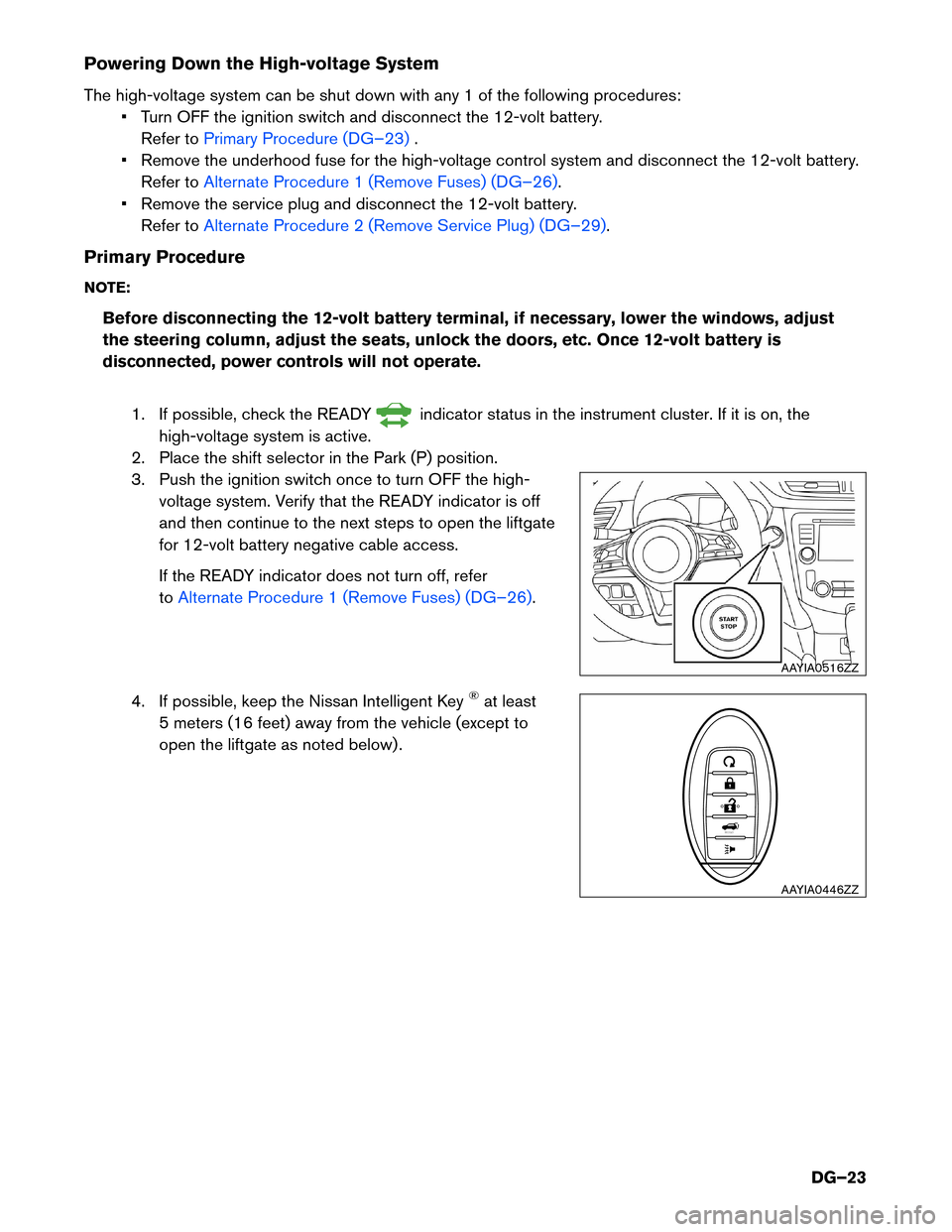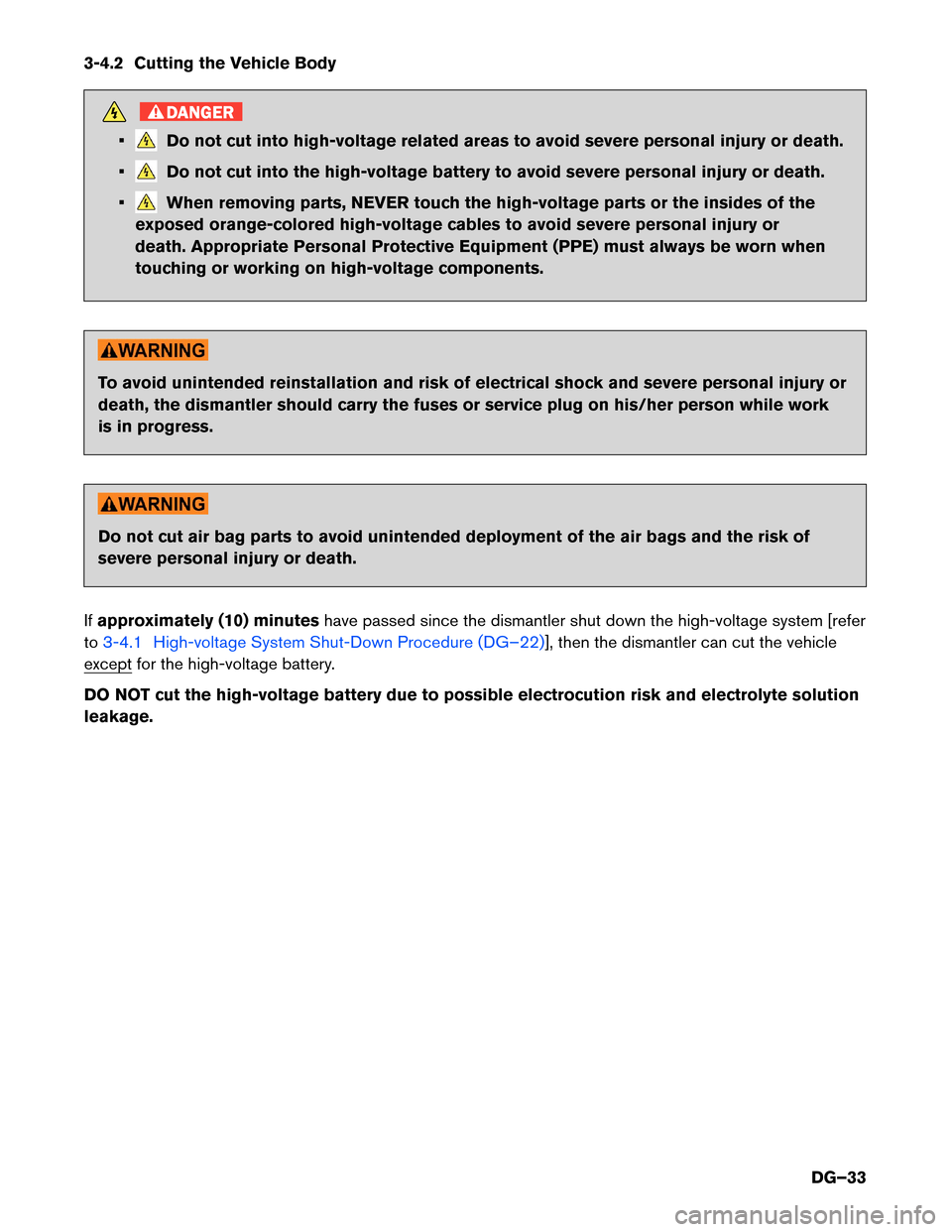Page 23 of 53

Powering Down the High-voltage System
The
high-voltage system can be shut down with any 1 of the following procedures:• Turn OFF the ignition switch and disconnect the 12-volt battery. Refer to Primary Procedure (DG–23) .
•
Remove the underhood fuse for the high-voltage control system and disconnect the 12-volt battery.
Refer to Alternate Procedure 1 (Remove Fuses) (DG–26).
•
Remove the service plug and disconnect the 12-volt battery.
Refer to Alternate Procedure 2 (Remove Service Plug) (DG–29).
Primary
Procedure
NOTE:
Before disconnecting the 12-volt battery terminal, if necessary, lower the windows, adjust
the steering column, adjust the seats, unlock the doors, etc. Once 12-volt battery is
disconnected, power controls will not operate.
1. If possible, check the READY indicator status in the instrument cluster. If it is on, the
high-voltage
system is active.
2. Place the shift selector in the Park (P) position.
3. Push the ignition switch once to turn OFF the high- voltage system. Verify that the READY indicator is off
and then continue to the next steps to open the liftgate
for 12-volt battery negative cable access.
If the READY indicator does not turn off, refer
toAlternate Procedure 1 (Remove Fuses) (DG–26).
4.
If possible, keep the Nissan Intelligent Key
®at least
5 meters (16 feet) away from the vehicle (except to
open the liftgate as noted below) . AAYIA0516ZZ
HOLD
AAYIA0446ZZ
DG–23
Page 26 of 53
8. Disconnect negative (-) battery cable and cover it with
insulated tape.
9. Wait approximately ten (10) minutes for complete discharge of the high-voltage capacitor
after the battery cable has been disconnected.
10. Perform the dismantling operation. Refer to 6. Dismantling Information (DG–43).
Alternate
Procedure 1 (Remove Fuses)
NOTE:
Before removing any fuses, if necessary, lower the windows, adjust the steering column,
adjust the seats, unlock the doors, etc. Once fuses are removed, power controls will not
operate.
1. Pull release handle located on the instrument panel and push the release lever under the hoodsideways to open hood.
2. Release clips on the narrow ends of the fuse box cover and remove it. : Vehicle front AAYIA0538ZZ
AAYIA0539ZZ
AAYIA0540ZZ
DG–26
Page 27 of 53
3. Remove IGCT RLY fuse (F/L 50A IGCT RLY) .
: Vehicle front
4.
If you cannot identify the correct fuse, remove all the
fuses. To avoid unintended reinstallation and risk of
electrical
shock and severe personal injury or death, the
dismantler should carry the fuse or fuses on his/her
person and cover the fuse box with insulated tape.
5. Open luggage compartment, release the 2 push pinretainers (A)and lift rear luggage board. Detach the
2 straps (B)and remove the rear luggage board. AAYIA0176GB
AAYIA0535ZZ
DG–27
Page 33 of 53

3-4.2 Cutting the Vehicle Body
DANGER
• Do not cut into high-voltage related areas to avoid severe personal injury or death.
• Do not cut into the high-voltage battery to avoid severe personal injury or death.
• When removing parts, NEVER touch the high-voltage parts or the insides of the
exposed orange-colored high-voltage cables to avoid severe personal injury or
death. Appropriate Personal Protective Equipment (PPE) must always be worn when
touching or working on high-voltage components. To avoid unintended reinstallation and risk of electrical shock and severe personal injury or
death,
the dismantler should carry the fuses or service plug on his/her person while work
is in progress. Do not cut air bag parts to avoid unintended deployment of the air bags and the risk of
severe
personal injury or death.
If approximately (10) minutes have passed since the dismantler shut down the high-voltage system [refer
to 3-4.1 High-voltage System Shut-Down Procedure (DG–22)], then the dismantler can cut the vehicle
except
for the high-voltage battery. DO NOT cut the high-voltage battery due to possible electrocution risk and electrolyte solution
leakage.
DG–33